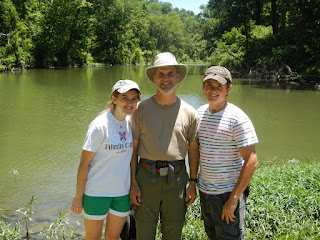I have my five senses, binoculars, and a magnifying lens. I have nature guidebooks galore and a college degree in biology. I have good hiking boots, water bottle, rain jacket, and everything else an adventurer should carry in the field. When I get home, I have even more books and Google and all the information of the world wide web to verify what I think I observed.
I can use these tools and walk for miles and miles through sunshine and rain, moonlight and snow, over hill and valley, but without one crucial skill, it would all be for nothing. It may lie dormant, but this crucial ability seems to be innate in the human psyche. It may need exercise to reawaken, but it seems to be there in all of us. It is, as Rachel Carson termed it, our sense of wonder.
 |
| Beach discovery (March 2004) |
It is this sense of wonder, this joy of discovery, that turns a simple walk into a meaningful encounter with the natural world. And it is precisely this encounter with nature that makes all the difference. Indeed, there is now much research to support the importance of experiencing nature firsthand. If you're interested, a good place to start looking into this would be the writings of
Richard Louv and
The Children & Nature Network). But the most important thing is to simply get outside and look. Engage your sense of wonder.
The stars are blazing overhead nightly, and yet mostly remain ignored. We could blame it on our electronics, and we could complain that the city lights are too bright anyway, but if we don't go out and look, then we will definitely never see. And if we never see, it will be as though we were blind.
The ephemeral spring wildflowers are blooming now, whether we're watching or not. And they will all be gone in a few short weeks, whether we're ready or not. Why not go out and see them now? It matters not if you know their names (though recognition raises the enjoyment level); what really matters is whether or not you experience and wonder at their beauty.
Soon many of us will be heading to beaches for spring breaks. The sun on our skin will feel wonderful and bring rejuvenation; the wind and the rhythm of the surf will soothe and medicate our souls. Unsure what to do with so much free time, many people will attempt to fill the void with books and an iPod full of music. Books and music are good and wonderful things, but do yourself a favor and do a little more. Unplug the music, put down the book for a few minutes, and simply go for a walk. Look at seagulls, watch the wave patterns in the sand, marvel at seashells, look for all the tiny living things in the edge of the surf. Engage your sense of wonder, and be refreshed.
Take a suggestion from Rachel Carson, and ask yourself, "What if I had never seen this before? What if I knew I would never see it again?" Listen carefully to her words below from
The Sense of Wonder (First published in 1956 as a magazine article, "Help Your Child to Wonder."
Click here for the original article.)
“Exploring nature….is largely a matter of becoming receptive to what lies all around you. It is learning again to use your eyes, ears, nostrils and finger tips, using your senses. For most of us, knowledge of our world comes largely through sight, yet we look about with such unseeing eyes that we are partially blind. One way to open your eyes to unnoticed beauty is to ask yourself. ‘What if I had never seen this before? What if I knew I would never see it again?’














































